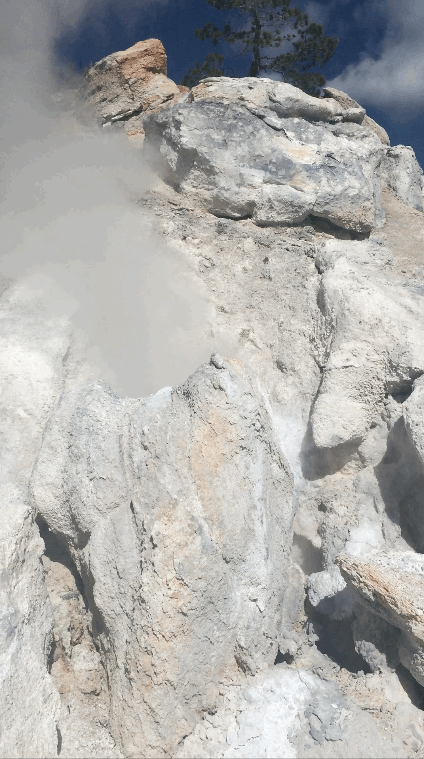Yellowstone is the site of the largest geothermal system in North America, which is fueled by a giant magma reservoir that is only 4 km beneath the surface. The most recent supereruption took place 640,000 years ago, which ejected >1,0003 km (240 mi3) of material and produced the 45 x 85 km (28 x 53 mi) Yellowstone Caldera. Post caldera lava flows erupted along vents within the caldera between 180,000 and 70,000 years ago. No magmatic eruptions have occurred within the Yellowstone Plateau volcanic field since. Future eruptions will likely occur, but the timing and magnitude of these eruptions are difficult to predict.
 |
| A small grizzly bear in Yellowstone |
 |
Lower Yellowstone Falls in the Grand Canyon of Yellowstone
|
The best clues to Yellowstone’s explosive history and it’s future, may be the gases and waters emitted from the complex hydrothermal system. Many gases are driven off of rocks beneath the surface, while other gases originate directly from the deep magma reservoir. The most abundant gases emitted from the various geothermal features are water vapor (steam) and CO2, which account for over 99.5% of gases present. Other gases include H2S (rotten egg smell), CH4 (methane) and C2H6(ethane).
 |
Grand Prismatic
Spring on our day off |
For the last dozen years or so, the Yellowstone Volcano Observatory (YVO) has made an effort to further understand the relationship between geothermal gases and the underlying volcano in Yellowstone. Scientists collect gases from various areas within the Yellowstone area and then measure the concentration of gases and isotopes in the lab. These data are being compiled over the years and will be used to track changes and hopefully detect signs of unrest in the future.
 |
| Norris Geyser Basin |
I spent a week collecting volcanic gases with Dr. Jacob Lowenstern, Dr. Deborah Bergfeld and a fellow graduate student in various locations throughout the Yellowstone Plateau volcanic field. Generally, two distinct geothermal systems were observed in Yellowstone; 1) neutral chloride waters and 2) acid sulfate waters/mud. Both systems are of interest and exhibit unique geologic characteristics.
 |
Gases are collected in a sodium
hydroxide vacuum, which captures
trace gases and condenses the
steam to water |
Neutral chloride water has neutral pH water and is chloride-silica rich. The mafic (Fe and Mg rich) minerals present in the bedrock are typically altered by the water and change to various other minerals (e.g., goethite, hematite, and chalcedony). Plagioclase typically alters to siliceous sinter and montmorillonite (clay). The geysers and colorful springs present in Yellowstone are neutral chloride systems.
 |
| Fumerole |
 |
| Super-heated gases |
Concentrations of gases and isotopes from a single field season do not reveal much. Yet as the work continues in Yellowstone, data may serve more useful in understanding the intricacies of the geothermal system and its’ relationship to the underlying volcano.
 |
Deb looking for a good location to collect gases in the
Mud Volcano area |
 |
| Deb preparing to sample gases from Opalescent Spring |
 |
| Jake and Deb collecting gases bubbling at the surface of Opalescent Spring |
 |
| Cinder Pool named after the sulfur cinder that rises and floats on the surface of the spring |
 |
| Geyserite (a form of siliceous sinter) deposited along the edges of a spring in Norris Geyser Basin |
 |
| Jake explaining our work to curious tourists in Norris Geyser Basin |
 |
| Tall unique deposit of geyserite |
 |
| Making the 10-mile trek through the backcountry to Glen Africa Basin to collect gases |
 |
| Glen Africa Basin |
 |
| Colorful springs in Glen Africa Basin |
 |
| Collecting gases straight from a fumarole using an “Italian Rod” in the Mud Volcano Area with dozens of tourists curiously looking on |

|
| William, Jake, and Deb all hard at work in Glen Africa Basin |
 |
| Mudpot in Violet Springs Basin |
 |
| Acid sulfate mudpots in Violet Springs Basin |
 |
| Sulfur deposit in Violet Springs Basin |

















![]() This work is licensed under a Creative Commons Attribution-NonCommercial-ShareAlike 4.0 International License.
This work is licensed under a Creative Commons Attribution-NonCommercial-ShareAlike 4.0 International License.




